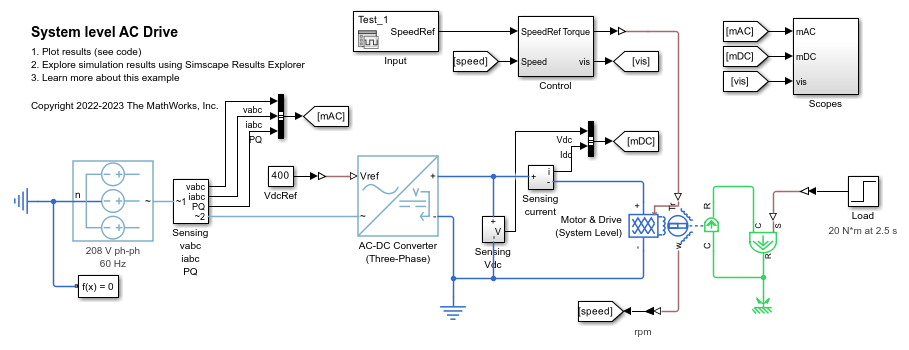AC-DC Converter (Three-Phase)
Libraries:
Simscape /
Electrical /
Semiconductors & Converters /
Converters
Description
This block represents the behavioral model of an AC-DC converter. Use this block to model AC-DC converters without simulating individual switching events. Use the DC voltage reference input to convert the electrical energy between the AC and DC sides.
This block is compatible with time simulation mode and frequency-and-time simulation mode.
Equations
At the DC side, if you set the Voltage dynamics at DC
side parameter to No dynamics, the
block calculates the output voltage,
VDC, by using this equation:
where Vref is the value of the input signal at the Vref port, D is the value of the Output DC voltage droop with output current parameter, and IDC is the output DC current.
If you set the Voltage dynamics at DC side parameter to
Specify voltage regulation time constant, the
block calculates the output voltage,
VDC, by using this equation:
where τDC is the value of the Voltage regulation time constant at DC side parameter.
The power at the DC side is
If you set the Power balance dynamics parameter to
No dynamics, the input power at the AC side is
equal to the output power at the DC side.
If you set the Power balance dynamics parameter to
Specify power time constant, the block calculates
the input power at the AC side by using this equation:
where τP is the value of the Power balance time constant parameter.
To determine the three-phase input currents at the AC side, the block first calculates the dq-axes voltages, vd and vq, using the Park transform on the abc-phase voltages, va, vb, and vc:
where is the angle of the synchronously rotating reference frame.
The block then calculates the three-phase AC currents, ia, ib, and ic, by using these power equations:
From these equations, the dq-axes currents, id and iq, are
where vdx and vqx are obtained from these equations:
where τAC is the value of the Voltage time constant at AC side parameter.
Finally, the block calculates the three-phase AC currents that flow into the converter by using this equation:
Examples
Limitations
The AC-DC Converter (Three-Phase) block does not model the power losses.
Ports
Input
Conserving
Parameters
Extended Capabilities
Version History
Introduced in R2022b

